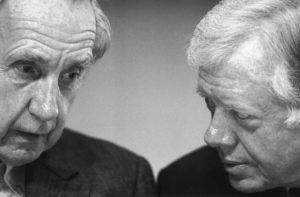July 2, 2024, marked the 60th anniversary of the passage of the Civil Rights Act of 1964. Though Black women played crucial roles organizing and leading efforts in the fight for equal rights, many mainstream histories ignore their contributions. The reality is that Black women took on important strategic roles at the local level—even as they were denied recognition at the national level. They served as activists, scholars, and organizers who established crucial connections between grassroots and national organizations. The three women highlighted below are only a few of the many women who worked and sacrificed to keep the movement going.
Fannie Lou Hamer
In 1962, at the age of 44, Fannie Lou Hamer tried to register to vote. She travelled with 17 other civil rights activists to the courthouse in Indianola, Mississippi. They were told they had to pass a literacy test before they could register. After nervously completing the test, the group boarded their bus to return home. On the way, they were stopped by the police and fined for driving a bus that was supposedly “too yellow.”1 When Hamer got home that night, the white owner of the plantation on which she lived with her husband threatened to kick them out of their home if she didn’t return to the courthouse and withdraw her registration. Several days later, white supremacists shot 16 bullets into the home where Hamer was staying. Her family was unharmed, and Hamer was undeterred in her fight.
A year later, Hamer was traveling home to Mississippi after attending a voter’s workshop in South Carolina. She was traveling with other activists, and the group decided to stop and eat. After they were refused service from the restaurant owner, police circled their bus and began making arrests. Over the next four days, Hamer was brutally beaten in the Winona jailhouse as she was interrogated about her involvement with voter-registration workshops. The beatings left Hamer with permanent kidney damage and a blood clot behind her eye, but she remained dedicated to her cause. She went on to co-found the Mississippi Freedom Democratic Party and attended the Democratic National Convention to challenge the all-white Democratic delegation to represent the state of Mississippi. Hamer made a passionate speech that described the systematic disenfranchisement and oppressive conditions under which Black Mississippians lived their daily lives. The televised speech generated public outcry and set in motion the 1965 passage of the Voting Rights Act which banned, among other things, local laws like literacy tests that blocked African Americans from the ballot box.
Mamie Till-Mobley
In September of 1955, Mamie Till-Mobley made a choice that galvanized the civil rights movement. When the body of her 14-year-old son, Emmett Till, was found in the Tallahatchie River, Till-Mobley fought to have his body returned to their hometown of Chicago. Though the authorities in Mississippi tried to bury Till’s body as soon as possible, she knew his story needed to be told.
Emmett Till had been brutally beaten and shot after Carolyn Bryant, a white woman, accused him of whistling at her in a grocery store. Till had travelled from Chicago to visit family and wasn’t used to the unspoken rules Black people had to follow in Mississippi. Having grown up visiting family in Mississippi every summer, his mother knew the dangers her son faced and tried to warn him. When a car arrived in the middle of the night and two men took Till out of the family house where he was staying, the family feared the worst had happened. On August 31, 1955, three days after he went missing, Till’s mutilated body was found.
Defying the Mississippi sheriff’s order that the coffin remain sealed, Till-Mobley held an open casket funeral so that mourners “could witness how Emmett’s face was disfigured beyond recognition.”2 She invited photographers to take pictures of her son’s body, and the pictures were published in widely circulated Black magazines. The images reached thousands of African Americans across the nation and roused them into actively joining the civil rights movement. Till-Mobley never stopped telling her son’s story, making sure “for an entire nation, there no longer could be any innocent bystanders.”3 Her bravery continues to resonate today, as President Biden signed the Emmett Till Antilynching Act in 2022, which officially designated lynching as a federal hate crime.
Diane Nash
Born and raised in Chicago, Diane Nash didn’t truly understand the harsh reality of segregation until she began attending Fisk University in Nashville, Tennessee. While there, she co-founded the Student Nonviolent Coordinating Committee (SNCC) to unite students in the fight against segregation. Nash went on to emerge as one of the most successful activists of the time.
In 1960, at the age of 22, Nash became the leader of the Nashville sit-ins, which were nonviolent protests to end racial segregation at lunch counters. Over 150 students were arrested during the sit-ins, which lasted from February to May of 1960. As a result of pressure from the sit-ins, Nashville began desegregating public facilities—a full four years before the Civil Rights Act of 1964.4
In 1961, in the wake of the violent attack on the Freedom Riders challenging the segregation of interstate busses and facilities in Alabama, Nash called on Fisk University students to fill buses and keep the Freedom Rides going. She took over responsibility for the Freedom Rides by recruiting riders, acting as media spokesperson, and working to secure support from government officials and leaders of the civil rights movement. In recognition of her work and success as an organizer, the planning committee for the 1963 March on Washington nominated Nash to speak on the national stage. Ultimately, no women were allowed to address the crowd as official speakers during the march, underscoring the lack of recognition that women faced within the movement.
Undeterred by the lack of official recognition, Nash and her husband James Bevel continued to be crucial organizers of the nonviolent movement in Alabama. Together with her husband, Nash spearheaded the three 1965 marches from Selma to Montgomery to push for voting rights in Alabama. The marches, met with violence by Alabama law enforcement officials, would become a watershed moment that led to the passing of the Voting Rights Act of 1965.
Notes:
- Keisha Blain, “Fannie Lou Hamer’s Dauntless Fight for Black Americans’ Right to Vote,” Smithsonian Magazine, 2020.
- Maruice Berger, “The Lasting Power of Emmett Till’s Image,” The New York Times, 2017. The Lasting Power of Emmett Till’s Image – The New York Times (nytimes.com)
- Ellen Wexler, “How Emmett Till’s Mother Galvanized the Civil Rights Movement,” Smithsonian Magazine, 2022.
- Lucia Cheng, “Meet Diane Nash, the Civil Rights Icon Awarded the U.S.’ Highest Civilian Honor,” Smithsonian Magazine, 2022.




